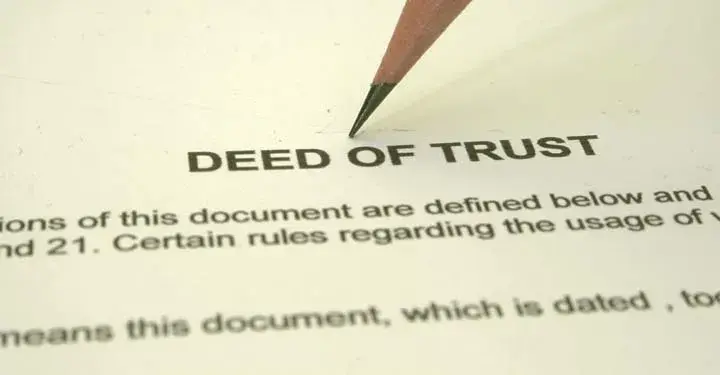
A deed of trust is used to secure a loan on real property. Learn how this legal document can be an easy way for a lender to collateralize a loan.
Find out more about property owners


by Brette Sember, J.D.
Brette is a former attorney and has been a writer and editor for more than 25 years. She is the author of more than 4.
Updated on: July 29, 2024 · 2 min read
A deed of trust is a legal document that essentially puts a piece of property up as collateral for a loan. Although sometimes used in place of a mortgage, a deed of trust functions differently and makes foreclosing on the property simple for the lender.

A deed of trust is used with a loan when real property is used to secure the loan. The deed gives the lender the right to receive the proceeds of the sale of the property at auction if the loan is not paid. Unlike a warranty deed, which immediately transfers the owner's rights in the property to the buyer, a deed of trust is not intended to transfer title to a property unless the loan is unpaid.
A deed of trust has three parties:
A mortgage and a deed of trust are both used to secure a loan, which is a separate document. One difference between these two legal documents is that a deed of trust has three parties (trustor, lender, and trustee) while a mortgage has only two (lender and borrower). In the case of a mortgage, if a borrower does not pay the associated loan, the property must be foreclosed on in court so that the lender can sell it. A deed of trust, on the other hand, does not require a court process. The trustee can sell the property without a court order if the trustor does not pay. Because of this, a deed of trust allows for a faster and less expensive process if the loan is not paid.
A wraparound mortgage, also known as an inclusive deed of trust, is used when there is an existing mortgage on the property that remains in place. For example, Sandra has a mortgage on her home. Marco buys the home with the promise to pay her the monthly mortgage amount she owes, which Sandra then uses to pay the mortgage in her name. This arrangement is made legally binding with a deed of trust. If Marco doesn't pay Sandra, she forecloses and gets the property back without a court proceeding. So in essence, Marco's loan wraps around the existing mortgage to cover it, hence the name for this type of deed of trust.
Like any deed, a deed of trust can be transferred from one person to another, similar to the way a bank can sell a loan to another bank. The document that transfers a deed of trust, called an assignment of a deed of trust, must be filed in the county clerk's office to be valid.
A deed of trust is a convenient way to avoid a court proceeding if a loan is not paid. This type of nonjudicial foreclosure is quick and inexpensive for the person or company lending the money. You can prepare a deed of trust yourself or you can use an online service provider.
Find out more about Property OwnersThis article is for informational purposes. This content is not legal advice, it is the expression of the author and has not been evaluated by LegalZoom for accuracy or changes in the law.
You may also like
By knowing what other trademarks are out there, you will understand if there is room for the mark that you want to protect. It is better to find out early, so you can find a mark that will be easier to protect.
July 31, 2024 · 4min read
A power of attorney can give trusted individuals the power to make decisions on your behalf—but only in certain situations.
August 29, 2024 · 20min read
2024 is one of the best years ever to start an LLC, and you can create yours in only a few steps.
July 29, 2024 · 22min read